New York City has always been a trendsetter when it comes to fashion. Its streets serve as an open runway, where influences from different eras, cultures, and subcultures blend to create something fresh and unique. New York street style is a fusion of expression, individuality, and creativity. From the bold, rebellious looks of the 90s to the polished high-low mix of today, the city’s street style has continued to evolve while staying true to its roots in diversity and innovation.
Street style isn’t just about clothes—it’s about identity. In New York, fashion speaks loudly about who you are, where you come from, and what you stand for. Over the decades, this has meant everything from oversized jackets and bold accessories to sleek, minimalist designs. But no matter the era, New York street style remains a reflection of the city’s vibrant, ever-changing spirit.
The 90s: Bold, Rebellious, and Influential
In the 1990s, New York street style was at the intersection of cultural movements that were shaping music, art, and social consciousness. The decade was defined by a rebellious, DIY ethos, with fashion choices often mirroring the raw energy of the city itself. Hip-hop was emerging as a cultural powerhouse, and its influence was clear in street style—baggy jeans, oversized jackets, and graphic tees became everyday essentials. These looks were not just about comfort—they were about defiance and standing out in a crowded city.
Grunge and punk rock were also making waves, contributing to a style that rejected traditional fashion norms in favor of something more rugged and personal. People began mixing vintage finds with bold, new streetwear, creating an eclectic look that still resonates today. Accessories were a huge part of 90s street fashion. Chains, caps, and custom pieces like Personalized Men Bracelets added an individual touch to a casual, often oversized outfit. The personal element of accessories, especially customized ones, allowed people to turn even the simplest outfit into a reflection of their unique identity.
The 90s street style scene was also influenced by the growing skateboarding culture. Skate-inspired looks, with their graphic tees, loose pants, and durable sneakers, became ubiquitous in New York’s street fashion, marking an important shift in how young people dressed. Comfort and function became just as important as style, with accessories and DIY elements adding personal flair to every outfit.
Quote: “Street style in New York during the 90s was about rebellion. It was about taking risks and using fashion as a way to express your individuality in a city that’s constantly moving.”
The Rise of Streetwear in the Late 90s
As the 90s progressed, streetwear began to take on a life of its own, especially in New York. Brands like FUBU, Phat Farm, and Rocawear were born out of the city’s hip-hop scene, blending music, street culture, and fashion. These brands catered to a generation that wanted clothing that represented their lifestyle—bold, unapologetic, and reflective of their roots. Streetwear quickly gained popularity, making its way from niche neighborhoods into the mainstream, setting the stage for the dominance of urban fashion in the decades to come.
What made 90s street style so influential was its ability to pull from so many different cultural movements. Whether you were into skate culture, hip-hop, or punk rock, there was a place for you in the fashion landscape. People weren’t afraid to mix elements of different subcultures, resulting in outfits that were entirely their own. The late 90s became a melting pot of styles, and that diversity was reflected in how New Yorkers dressed.
Accessories became staples in this era, offering a touch of individuality and self-expression. Whether it was through bold chain links or engraved bracelets, customization played a big role in street fashion, allowing people to craft looks that felt authentically theirs.
Tip: To capture the essence of 90s New York street style, look for bold accessories that reflect your personality. Adding personalized touches to your outfit can blend past and present streetwear trends.
The 2000s: Blending Streetwear with High Fashion
As we transitioned into the 2000s, New York street style started evolving into something more polished, as high fashion began blending with streetwear. The early 2000s saw brands like Supreme and BAPE dominating the urban fashion scene, while designers from the high-end world began to take notice. Streetwear began to influence luxury collections, creating a unique synergy between the streets and the runways.
In this era, oversized hoodies, sneakers, and graphic designs remained prominent, but they were often paired with more polished pieces like designer bags or luxury accessories. The mix of high and low fashion became a defining characteristic of this time, making New York’s streets an exciting place for experimentation. People were no longer choosing between streetwear or high fashion—they were combining both in bold, creative ways.
The influence of celebrities also started playing a bigger role in shaping New York street style in the 2000s. Stars like Jay-Z, Alicia Keys, and Pharrell Williams were often seen sporting a mix of luxury brands and streetwear, creating looks that were both aspirational and accessible. This period marked the rise of athleisure as well, as fitness and fashion merged with casualwear becoming not only acceptable but fashionable in everyday life.
Tip: To recreate the 2000s high-low street style mix, try pairing luxury items with more casual streetwear pieces, like sneakers with tailored pants or a hoodie under a designer blazer.
The 2010s: Diversity, Identity, and Self-Expression
As the 2010s rolled in, New York street style became more diverse and experimental than ever before. The decade was marked by an explosion of self-expression, with people embracing unique fashion choices that represented their cultural background, personal identity, and creative spirit. The fashion scene became more inclusive, reflecting the diversity of the city itself.
This was also the era when street style started becoming heavily influenced by social media. Platforms like Instagram and Pinterest allowed individuals to showcase their personal style to a global audience. Bloggers and influencers started to play a major role in shaping trends, making fashion more accessible and fluid.
The 2010s also saw a rise in the symbolic meaning of numbers and spirituality in fashion. For instance, the 1010 Angel Number became a popular reference for individuals seeking spiritual alignment and new beginnings. This sense of personal journey and meaning found its way into street style, with people incorporating such symbols into their accessories, tattoos, or even custom clothing designs. Fashion, during this time, became a deeply personal reflection of the wearer’s story.
The Influence of Social Media on New York Street Style
In the age of social media, New York street style truly came into its own. What was once an underground, localized phenomenon became a global conversation. Thanks to platforms like Instagram, New York’s fashion-forward residents were able to showcase their looks to the world, turning the city’s sidewalks into a digital runway. Fashion influencers and bloggers began dictating trends, often faster than traditional fashion magazines and runways could.
Social media also helped democratize fashion. No longer was street style confined to the fashion capitals or the rich and famous. Everyday people could now become trendsetters, and fashion choices were being celebrated for their originality rather than their price tag. This shift allowed street fashion to flourish, with more diversity and creativity than ever before.
The 2020s: Sustainability, Inclusivity, and Innovation
As we entered the 2020s, New York street style has continued to evolve, embracing sustainability, inclusivity, and technological innovation. More than ever, people are making conscious choices about what they wear and where it comes from. Sustainable fashion has become a key focus, with many New Yorkers opting for eco-friendly materials, upcycled clothing, and supporting ethical brands that prioritize transparency and fair labor practices.
Inclusivity has also become central to modern street fashion. Gender-neutral clothing lines, size-inclusive collections, and designs that celebrate diverse identities are all part of a new wave of fashion that embraces everyone. No longer confined to rigid gender norms or size standards, fashion has become a tool for expressing personal identity and celebrating individuality.
At the same time, innovation is transforming the way New Yorkers approach fashion. Wearable technology, such as smart fabrics and accessories that track fitness or integrate with mobile apps, is becoming increasingly common. Fashion is no longer just about aesthetics—it’s becoming functional, smart, and adaptive to the lifestyle of a fast-paced city like New York.
Quote: “The fashion choices we make today are not just about looking good. They reflect our values, our sense of identity, and our commitment to sustainability and innovation.”
The Future of New York Street Style
As we look to the future, New York street style is poised to keep pushing boundaries. With its diverse culture, vibrant energy, and constant innovation, the city will undoubtedly continue to influence global fashion trends. The blending of high fashion and streetwear will likely remain a key theme, as will the focus on sustainability and inclusivity. Technology will also continue to shape how people dress, with smart clothing and virtual fashion shows already making their mark on the industry.
What makes New York street style truly special is its ability to constantly evolve while remaining deeply connected to the city’s spirit of creativity and individuality. No matter how trends come and go, New York will always be a place where fashion is about more than just clothes—it’s about making a statement, telling a story, and being unapologetically yourself.
The Future of New York Street Style
As we look to the future, New York street style is poised to keep pushing boundaries. With its diverse culture, vibrant energy, and constant innovation, the city will undoubtedly continue to influence global fashion trends. The blending of high fashion and streetwear will likely remain a key theme, as will the focus on sustainability and inclusivity. Technology will also continue to shape how people dress, with smart clothing and virtual fashion shows already making their mark on the industry.
What makes New York street style truly special is its ability to constantly evolve while remaining deeply connected to the city’s spirit of creativity and individuality. No matter how trends come and go, New York will always be a place where fashion is about more than just clothes—it’s about making a statement, telling a story, and being unapologetically yourself.
As the fashion landscape continues to shift, one thing remains true: New York City’s streets will forever be a place where style is not just seen, but lived. From iconic subcultures to emerging trends, the sidewalks of New York will always reflect the ever-changing pulse of global fashion, making it one of the influential cities in the world for street style.
Published by: Josh Tatunay



















